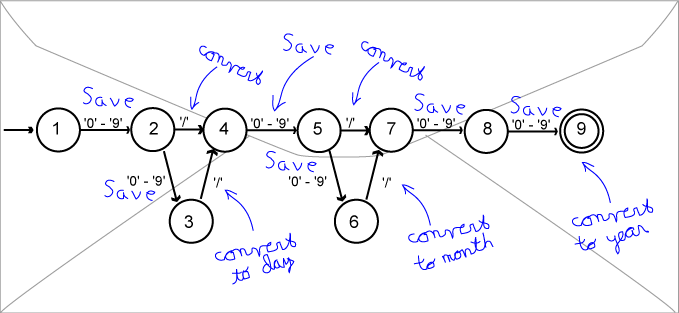Answer:


Once you have an automaton that recognizes the data,
adding statements that perform the
right actions takes a few more steps.
Look at this method which implements the date automaton.
It returns a MyDate object if the
argument is valid, or null if not.
But it is not quite complete.
It still needs a few more steps.
MyDate convert( String str )
{
int reject= 10; // rejection state
int state = 1; // the current state
char current; // the current character
int index = 0 ; // index of the current character
while ( index < str.length() && state != reject )
{
current = str.charAt( index++ ) ;
if ( state==1 && current >= '0' && current <= '9')
{
state = 2;
}
else if ( state==2 && current=='/' )
{
state = 4;
}
else if ( state==2 && current >= '0' && current <= '9' )
{
state = 3;
}
else if ( state==3 && current=='/' )
{
state = 4;
}
else if ( state==4 && current >= '0' && current <= '9' )
{
state = 5;
}
else if ( state==5 && current=='/' )
{
state = 7;
}
else if ( state==5 && current >= '0' && current <= '9' )
{
state = 6;
}
else if ( state==6 && current=='/' )
{
state = 7;
}
else if ( state==7 && current >= '0' && current <= '9' )
{
state = 8;
}
else if ( state==8 && current >= '0' && current <= '9' )
{
state = 9;
}
else
state = reject ;
}
if ( index == str.length() && state == 9 )
return new MyDate( day, month, year ) ;
else
return null ;
}
Your goal is to change the automaton as little as possible.
The automaton has solved the "recognize" part of the problem.
For the most part, you should just add statements to
the automaton to finish the "compute" part of the problem.
A few changes have been made to the original automaton:
the return type MyDate is constructed in the last
if-else
of the method.
To start, look at the code (and the envelope) and decide what new variables need to be added.